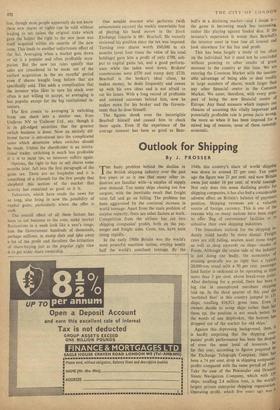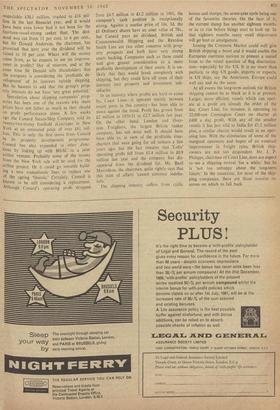Outlook for Shipping
By J. PROSSER ryire basic problem behind the decline in I the British shipping industry over the past five years or so is one that many other in- dustries are familiar with—a surplus of supply over demand. Too many ships chasing too few cargoes, with the inevitable result that freight rates fall and go on falling. The problem has been aggravated by the continual increase in world tonnage. Apart from the main problem of surplus capacity, there are other factors at work. Competition from the airlines has cut into shipping companies' profits, both on the pas- senger and freight sides. Costs, too, have been rising rapidly.
In the early 1900s Britain was the world's most powerful maritime nation, owning nearly half the world's merchant tonnage. By the 1940s this country's share of world shipping was down to around 27 per cent. Ten years ago the figure was 21 per cent. and now Britain owns just under 16 per cent. of world tonnage. Not only does this mean declining profits for shipping companies, it has also had a considerable adverse effect on Britain's balance of payments position. Shipping revenues are a valuable source of foreign currency. This is one of the reasons why so many nations have been eager to offer 'flag of convenience' facilities or to subsidise their own shipping industries.
The immediate outlook for the shipping in- dustry could hardly be more dismal. Freight rates are still falling, seamen want more wages as well as shop stewards on ships—shades of Fords. Although the cruise side of the industry is not doing too badly, the economics of cruising generally are so tight that a typical 20,000-ton vessel with a 90 per cent. passenger load factor is reckoned to be operating at little more than 3 per cent, above break-even point' After declining for a period, there has been 3 big rise in unemployed merchant shipping laid up. In the third quarter of this year the `mothball fleet' in this country jumped to 131 ships, totalling 818,921 gross tons. Even if owners decide to scrap ships rather than laY them up, the position is not much better. In the words of one shipbroker, 'the bottom has dropped out of the market for old ships.'
Against this depressing background, then, it is hardly surprising that the shipping corn-
panics' profit performance has been the despoir
of even the most loyal of investors. S' far this year, according to figures prepared laY the Exchange Telegraph Company, there has,
been a 74 per cent. drop in shipping companies profits compared with the same period of 1961.
Take the case of the Peninsular and Oriental Steam Navigation Company, which with 339 ships, totalling 2.4 million tons, is the world's largest private enterprise shipping organisation. Operating profit, which five years ago was a respectable £30.1 million, crashed to £16 mil- lion in the last financial year, and it would have been even lower had it not been for the fourteen-vessel-strong tanker fleet. The divi- dend was cut from 11 per cent. to 6 per cent., but Sir Donald Anderson, the chairman, has promised that next year the dividend will be raised to 10 per cent. Where will the money Come from, as he expects to see no improve- ment in profits? Out of reserves, and at the same time Sir Donald tells shareholders that the company is considering the 'profitable de- velopment' of its interests outside shipping. But he hastens to add that the group's prop- erty interests do not have `any great potential.'
Speculation about shipping companies' prop- erties has been one of the reasons why share prices have not fallen as much as they should on profit performance alone. A few weeks ago the Cunard Steam-Ship Company sold its twenty-two-storey freehold skyscraper in New York at an estimated price of over f61 mil- lion. This is only the first move from Cunard In its property development programme. Cunard has also expanded in other direc- tions by linking up with BOAC in a joint airline venture. Probably some of the money from the New York sale will be used for the airline project. Or it could go towards build- ing a new transatlantic liner to replace one of the ageing 'Queens.' Certainly, Cunard is known to be still considering a replacement. Although Cunard's operating profit dropped
from £4.5 million to £1.2 million in 1961, the company's cash position is exceptionally strong. Against a market price of 16s. 3d. the £1 Ordinary shares have an asset value of 78s., but Cunard pays no dividend. British and Commonwealth Shipping and the Reardon Smith Line are two other concerns with prop- erty prospects and both have very strong assets backing. Companies such as these could well give greater consideration to a more profitable development of their assets. It is un- likely that they would break completely with shipping. but they could hive off some of their interests into property and investment sub- sidiaries.
In an industry where profits are hard to come by, Coast Lines—it operates mainly between major ports in this country—has been able to move against the trend. Profit has grown from £2 million in 1950-51 to £2.7 million last year. On the other hand, London and Over- seas Freighters, the largest British tanker company, has not done well. It should have been able to, in view of the profitable time- charters that were going for oil tankers a few years ago, but the fact remains that 'Lofts' operating profit fell from £1.4 million to £0.9 million last year and the company has dis- appeared from the dividend list. Mr. Basil MaVroleon, the chairman, quite rightly says that this state of affairs 'cannot continue indefin- itely.' The shipping industry suffers from cyclic booms and slumps, the seven-year cycle being one of the favourite theories. On the face of it, the current slump has another eighteen months or so to run before things start to look up. In that eighteen months many small shipowners will go bust or amalgamate.
Joining the Common Market could well give British shipping a boost and it would enable the European maritime nations to present a united front to the vexed question of flag discrimina- tion—especially by the US. It is no more than patriotic to ship US goods, imports or exports, in. US ships, say the Americans. Europe could well say and do the same.
At all events the long-term outlook for British shipping cannot be as black as it is at present. Larger, more efficient vessels which can oper- ate at a profit are already the order of the day. Court Line, for instance, is operating its 22,000-ton Cressington Court on charter at £400 a day profit. With any of the smaller vessels it has just sold to India for £1.2 million plus, a similar charter would result in an oper- ating loss. With the elimination of some of the marginal operators and hopes of an eventual improvement in freight rates, British ship- owners are not too despondent. Mr. J. P. Philipps, chairman of Court Line, does not expect to see a shipping revival 'for a while,' but he is 'not too unhappy about the long-term future.' In the meantime, for most of the ship- ping companies, there are those massive re- serves on which to fall back.







































 Previous page
Previous page